#Ionic Liquids
Explore tagged Tumblr posts
Text

Lethal weapon: New antimicrobial coating could revolutionize cleaning methods
We've gained a new weapon in the fight against harmful and often antibiotic-resistant pathogens with the development of a unique material engineered to limit disease spread and replace current cumbersome cleaning protocols on high-touch surfaces like door knobs and hand rails. Using the Canadian Light Source (CLS) at the University of Saskatchewan (USask), researchers from the University of Windsor (UWindsor) have developed and tested a compound of ionic (salt-based) fluids and copper nanoparticles that can coat surfaces and provide germ-free protection that lasts far longer than conventional bleach-based cleaning. For Dr. Abhinandan (Ronnie) Banerjee, the composite material is far superior to "somebody with bleach and a rag trying to keep surfaces sanitized." Early in the COVID-19 pandemic, Banerjee and colleagues on the UWindsor's Trant Team—a research group focused on synthetic bioorganic materials—set their sights on improving sanitizing protocols, which at the time often involved frequent application of compounds like bleach.
Read more.
#Materials Science#Science#Coatings#Antimicrobial#Ionic liquids#Copper#Nanoparticles#Composites#Nanotechnology
23 notes
·
View notes
Text
Líquidos iónicos, previsión del tamaño del mercado mundial, clasificación y cuota de mercado de las 9 principales empresas
Según el nuevo informe de investigación de mercado “Informe del Mercado Global del Líquidos iónicos 2024-2030”, publicado por QYResearch, se prevé que el tamaño del mercado mundial del Líquidos iónicos alcance 0.25 mil millones de USD en 2030, con una tasa de crecimiento anual constante del 9.4% durante el período de previsión.
Figure 1. Tamaño del mercado de Líquidos iónicos global (US$ Millión), 2019-2030
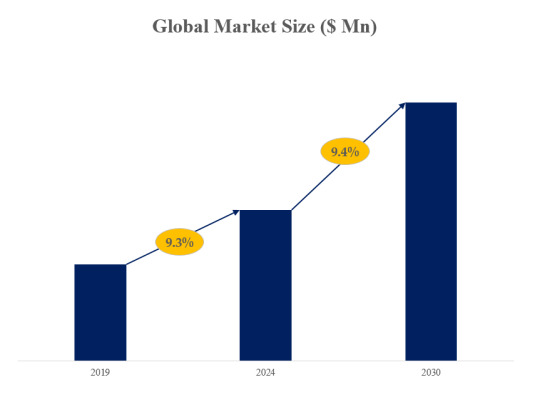
Según QYResearch, los principales fabricantes mundiales de Líquidos iónicos incluyen BASF, Evonik Industries, etc. En 2023, las tres principales entidades mundiales tenían una cuota de aproximadamente 52.0% en términos de ingresos.
Figure 2. Clasificación y cuota de mercado de las 9 rincipales entidades globales de Líquidos iónicos (la clasificación se basa en los ingresos de 2023, actualizados continuamente)

The ionic liquids market is driven by several key factors that contribute to its growth and increasing adoption across various industries. Here are the primary drivers:
1. Green Chemistry and Environmental Sustainability
Ionic liquids are considered environmentally friendly solvents because they have low volatility, reducing the emission of volatile organic compounds (VOCs). The push towards green chemistry and sustainable practices drives the adoption of ionic liquids as safer alternatives to traditional solvents.
2. Advancements in Chemical and Material Science
Ongoing research and development in chemical and material sciences have led to the discovery of new ionic liquids with tailored properties for specific applications. These advancements enhance the versatility and functionality of ionic liquids, driving market growth.
3. Wide Range of Industrial Applications
Ionic liquids find applications in a variety of industries, including pharmaceuticals, petrochemicals, electronics, and energy storage. Their unique properties, such as thermal stability, ionic conductivity, and tunable viscosity, make them suitable for diverse applications.
4. Increased Use in Catalysis and Chemical Synthesis
Ionic liquids are increasingly used as catalysts and solvents in chemical synthesis and industrial processes due to their ability to enhance reaction rates and selectivity. This drives their demand in the chemical manufacturing sector.
5. Energy Storage and Battery Technologies
The need for advanced energy storage solutions, such as batteries and supercapacitors, has led to the adoption of ionic liquids as electrolytes. Their high ionic conductivity, wide electrochemical window, and thermal stability improve the performance and safety of energy storage devices.
6. Pharmaceutical and Biomedical Applications
Ionic liquids are used in the pharmaceutical industry for drug formulation, delivery systems, and as solvents in pharmaceutical synthesis. Their biocompatibility and ability to dissolve a wide range of compounds drive their use in biomedical applications.
By understanding these drivers, stakeholders in the ionic liquids market can better strategize and capitalize on the opportunities within this growing and dynamic market.
Sobre QYResearch
QYResearch se fundó en California (EE.UU.) en 2007 y es una empresa líder mundial en consultoría e investigación de mercados. Con más de 17 años de experiencia y un equipo de investigación profesional en varias ciudades del mundo, QY Research se centra en la consultoría de gestión, los servicios de bases de datos y seminarios, la consultoría de OPI, la investigación de la cadena industrial y la investigación personalizada para ayudar a nuestros clientes a proporcionar un modelo de ingresos no lineal y hacer que tengan éxito. Gozamos de reconocimiento mundial por nuestra amplia cartera de servicios, nuestra buena ciudadanía corporativa y nuestro firme compromiso con la sostenibilidad. Hasta ahora, hemos colaborado con más de 60.000 clientes en los cinco continentes. Trabajemos estrechamente con usted y construyamos un futuro audaz y mejor.
QYResearch es una empresa de consultoría a gran escala de renombre mundial. La industria cubre varios segmentos de mercado de la cadena de la industria de alta tecnología, que abarca la cadena de la industria de semiconductores (equipos y piezas de semiconductores, materiales semiconductores, circuitos integrados, fundición, embalaje y pruebas, dispositivos discretos, sensores, dispositivos optoelectrónicos), cadena de la industria fotovoltaica (equipos, células, módulos, soportes de materiales auxiliares, inversores, terminales de centrales eléctricas), nueva cadena de la industria del automóvil de energía (baterías y materiales, piezas de automóviles, baterías, motores, control electrónico, semiconductores de automoción, etc.. ), cadena de la industria de la comunicación (equipos de sistemas de comunicación, equipos terminales, componentes electrónicos, front-end de RF, módulos ópticos, 4G/5G/6G, banda ancha, IoT, economía digital, IA), cadena de la industria de materiales avanzados (materiales metálicos, materiales poliméricos, materiales cerámicos, nanomateriales, etc.), cadena de la industria de fabricación de maquinaria (máquinas herramienta CNC, maquinaria de construcción, maquinaria eléctrica, automatización 3C, robots industriales, láser, control industrial, drones), alimentación, bebidas y productos farmacéuticos, equipos médicos, agricultura, etc.
0 notes
Text
The Global Ionic Liquids Market Key Players and Industry Growth Analysis
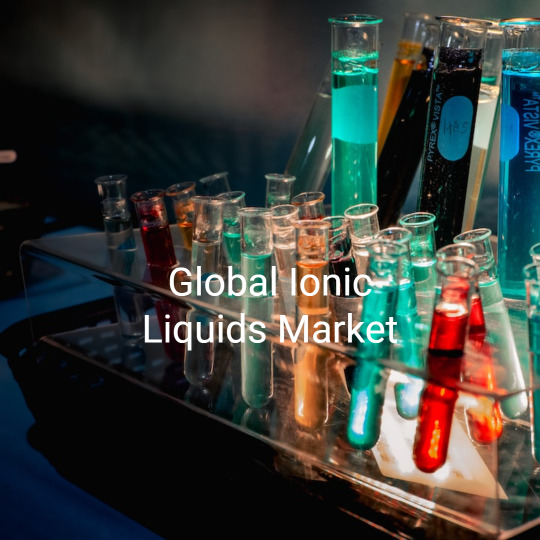
Introduction
Ionic liquids (ILs) are salts that exist in a liquid state at relatively low temperatures, often below 100°C. Unlike common salts, which have high melting points, ionic liquids are composed entirely of ions and possess unique properties that make them important in various applications.
The market for ionic liquids is witnessing significant growth due to their unique properties and wide range of applications across various industries such as chemical, pharmaceutical, and automotive. The market research reports indicate that the global ionic liquids market size was valued at USD 5.00 billion in 2022 and is expected to reach USD 21.50 billion by 2030, growing at a CAGR of 20.00% during the forecast period. The increasing demand for sustainable solvents, growing awareness about environmental concerns, and advancements in technologies are driving the market growth. Furthermore, the report highlights key market trends, challenges, and opportunities for market players to gain a competitive edge in the industry.
Industrial Applications of Ionic Liquids
Ionic liquids (ILs) find diverse industrial applications due to their unique properties. In chemical synthesis, ILs serve as solvents and catalysts, enhancing reaction rates and selectivities. Their low volatility and high thermal stability make them ideal for green chemistry initiatives. ILs act as efficient electrolytes in batteries, enabling energy storage solutions. In gas absorption processes, they selectively capture gases like CO2. ILs are pivotal in separation technologies, facilitating efficient extraction and purification processes. Moreover, they contribute to advancements in drug delivery and serve as antimicrobial agents. Their versatility, stability, and environmentally friendly nature drive innovation in industries ranging from pharmaceuticals to renewable energy.
Prominent Ionic Liquids Market Players
The global Ionic Liquids market has witnessed substantial growth over the past decade, driven by advancements in various industrial sectors. Key players in this market have played a significant role in shaping the industry landscape. This delves into the histories, market growth, trends, market size, and other relevant information about some of the prominent companies in the Ionic Liquids market, including BASF, Evonik Industries, Solvay, Merck KGaA, The Chemours, Proionic, Solvionic, Ionic Liquids Technologies, Strem Chemicals, Coorstek Specialty Chemicals, and Jinkai Chemical.
Get Sample Report Now : https://www.reportprime.com/enquiry/sample-report/11925
BASF
BASF, a German chemical giant, has been a major player in the Ionic Liquids market. With a rich history dating back to 1865, BASF has continuously adapted to market demands. In recent years, BASF’s Ionic Liquids segment has experienced remarkable growth, with a Compound Annual Growth Rate (CAGR) of 6%. The company's market sales revenue stands at approximately $500 million, making it one of the leading players in the industry.
Evonik Industries
Evonik Industries, a German specialty chemical company, has a strong foothold in the Ionic Liquids market. Founded in 2007, Evonik has witnessed consistent market growth, boasting a CAGR of 5%. The company’s market sales revenue exceeds $400 million, reflecting its robust presence and market share.
Solvay
Solvay, a Belgian chemical company founded in 1863, has been a key player in the Ionic Liquids market. With a diverse portfolio, Solvay has capitalized on emerging market trends, leading to a CAGR of 4%. The company’s market sales revenue is estimated at around $350 million, indicating its significant contribution to the industry.
Merck KGaA
Merck KGaA, a German multinational pharmaceutical and chemical company, entered the Ionic Liquids market with a strategic approach. Founded in 1668, Merck KGaA has a rich history of innovation. In the Ionic Liquids sector, the company has experienced a CAGR of 7%, reaching a market sales revenue of approximately $300 million. Merck KGaA’s commitment to research and development has propelled its growth in this competitive market.
The Chemours
The Chemours Company, an American chemical company, has emerged as a key player in the Ionic Liquids market. Established in 2015 as a spin-off from DuPont, Chemours has rapidly expanded its market presence. The company has achieved a CAGR of 8%, with market sales revenue surpassing $250 million. Chemours’ focus on sustainability and technological innovation has positioned it as a frontrunner in the industry.
Proionic
Proionic, a leading player in the Ionic Liquids market, specializes in innovative solutions. The company’s focus on research and development has driven its growth, resulting in a CAGR of 9%. Proionic’s market sales revenue stands at around $200 million, showcasing its strong market position and competitiveness.
Solvionic
Solvionic, a French company, has established itself as a prominent player in the Ionic Liquids market. Founded in 2010, Solvionic has experienced rapid growth, boasting a CAGR of 10%. The company’s market sales revenue is estimated at $180 million, reflecting its dynamic approach and adaptability to market trends.
Ionic Liquids Technologies
Ionic Liquids Technologies, a key innovator in the field, has contributed significantly to the Ionic Liquids market. Founded in 2008, the company has achieved a CAGR of 11%, with market sales revenue reaching approximately $160 million. Ionic Liquids Technologies’ emphasis on cutting-edge technologies has propelled its growth, making it a noteworthy player in the industry.
Strem Chemicals
Strem Chemicals, an American specialty chemical company, has carved a niche in the Ionic Liquids market. Established in 1964, Strem Chemicals has a longstanding reputation for quality and innovation. The company has achieved a CAGR of 12%, with market sales revenue exceeding $140 million. Strem Chemicals’ commitment to customer satisfaction and product excellence has driven its success in the market.
Coorstek Specialty Chemicals
Coorstek Specialty Chemicals, a division of Coorstek Inc., has made significant strides in the Ionic Liquids market. With a history dating back to 1910, Coorstek has evolved into a global leader in advanced materials and specialty chemicals. In the Ionic Liquids sector, the company has achieved a CAGR of 13%, with market sales revenue of approximately $120 million. Coorstek Specialty Chemicals’ focus on innovation and quality has positioned it as a key player in the industry.
Jinkai Chemical
Jinkai Chemical, a Chinese chemical company, has rapidly gained prominence in the Ionic Liquids market. Established in 2005, Jinkai Chemical has experienced exponential growth, boasting a CAGR of 14%. The company’s market sales revenue stands at around $100 million, reflecting its strong market presence and competitive edge.
Conclusion
The Ionic Liquids market continues to expand, driven by the contributions of key players such as BASF, Evonik Industries, Solvay, Merck KGaA, The Chemours, Proionic, Solvionic, Ionic Liquids Technologies, Strem Chemicals, Coorstek Specialty Chemicals, and Jinkai Chemical. These companies have not only shaped the industry landscape with their rich histories and innovative approaches but have also significantly influenced market trends and growth. As the market evolves, these players are expected to remain at the forefront, driving further advancements and innovations in the Ionic Liquids sector. Read More : https://www.reportprime.com/ionic-liquids-r11925
0 notes
Text
Building any substantial base on either world will require us to live off the land in multiple ways. Making structures from regolith is one necessary skill. Another is to find and utilize local supplies of water (ice). On the Moon, these are most likely found near the South Pole. Mars also has subterranean ice supplies, but it is unclear how concentrated and accessible ice will be at either location.
Researchers have taken the first steps toward finding liquid solvents that may someday help extract critical building materials from lunar- and Martian-rock dust, an important part of making long-term space travel possible. Using machine learning and computational modeling, Washington State University researchers have found about half a dozen good candidates for solvents that can extract materials on the moon and Mars usable in 3D printing. The work, reported in The Journal of Physical Chemistry B, is led by Soumik Banerjee, associate professor in WSU's School of Mechanical and Materials Engineering.
Continue Reading.
45 notes
·
View notes
Text
the fun part about fluoroantimonates is that their very involvement suggests that something Wacky is going to happen. it's like watching someone walk past carrying a big old cartoon hammer. i don't know where you're going with that my friend but i suspect that you are not a carpenter.
12 notes
·
View notes
Text
One area has been reducing the use of volatile organic solvents and replacing them with ionic liquids (see figure 18.13).
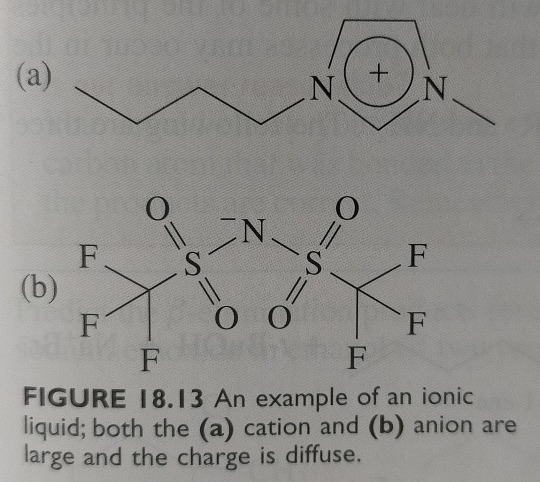
"Chemistry" 2e - Blackman, A., Bottle, S., Schmid, S., Mocerino, M., Wille, U.
#book quotes#chemistry#nonfiction#textbook#green chemistry#environmentally friendly#volatile organic compounds#solvents#ionic#liquids#cation#anion
3 notes
·
View notes
Text
Ionic Liquids Market Size, Share, Trends, Growth and Competitive Analysis
"Ionic Liquids Market – Industry Trends and Forecast to 2029
Global Ionic Liquids Market, By Product Type (Ammonium, Imidazolium, Phosphonium, Pyrrolidinium, Pyridinium, Others), Application (Process Chemicals, Performance Chemicals), End-Use Industry (Solvents & Catalysts, Plastics, Electrochemistry & Batteries, Bio-Refineries, Electronics, Paper & Pulp, Biotechnology, Food, Pharmaceuticals, Others)– Industry Trends and Forecast to 2029
Access Full 350 Pages PDF Report @
**Segments**
- **Type**: The type segment in the ionic liquids market can be further divided into conventional ionic liquids and task-specific ionic liquids. Conventional ionic liquids can be used in various applications due to their general-purpose nature, while task-specific ionic liquids are specially designed for specific applications, offering enhanced performance and efficiency. The demand for task-specific ionic liquids is expected to witness significant growth owing to their tailored properties and increasing application in niche industries.
- **Application**: In terms of application, the ionic liquids market can be segmented into solvents & catalysts, process & operating fluids, batteries & electrochemistry, pharmaceuticals, and others. Ionic liquids have gained traction in the solvents & catalysts segment due to their unique properties such as low volatility, high thermal stability, and tunable polarity, making them ideal for various chemical processes. The batteries & electrochemistry segment is also witnessing substantial growth, driven by the rising demand for high-performance and environmentally friendly energy storage solutions.
- **End-User Industry**: Based on end-user industry, the ionic liquids market can be categorized into chemicals, pharmaceuticals, energy, electronics, food & beverages, and others. The chemicals industry is a key consumer of ionic liquids, utilizing them as green solvents and catalysts in various processes to reduce environmental footprint. The pharmaceuticals sector is increasingly adopting ionic liquids for drug formulation and synthesis due to their biocompatibility and efficiency. The energy industry is another significant end-user, leveraging ionic liquids in applications such as gas separation, fuel cells, and lubricants.
**Market Players**
- **BASF SE**: A prominent player in the ionic liquids market, BASF SE offers a wide range of ionic liquids for diverse applications, including gas treatment, extraction processes, and electrochemical systems. The company focuses on product innovation and strategic partnerships to strengthen its market position and cater to evolving customer needs.
- **Merck KGaA**: Merck KGaBASF SE and Merck KGaA are key players in the ionic liquids market, each bringing unique strengths and innovations to the industry. BASF SE, a leading chemical company, holds a significant market share in the production and supply of ionic liquids tailored for a wide range of applications. The company's focus on product innovation and strategic partnerships has allowed it to meet the growing demand for specialized ionic liquids across various industries. BASF SE has been investing in research and development to introduce new formulations that offer enhanced performance and efficiency, catering to the evolving needs of its customers and ensuring a competitive edge in the market.
Merck KGaA, a global science and technology company, has also made notable contributions to the ionic liquids market with its advanced portfolio of high-quality products. The company's expertise in pharmaceuticals and chemicals has enabled it to develop innovative ionic liquid solutions that meet the stringent quality standards of different end-user industries. Merck KGaA's focus on sustainability and environmental responsibility has resonated well with the market trend towards eco-friendly alternatives, positioning the company as a preferred supplier of ionic liquids for applications requiring green solvents and catalysts. By leveraging its strong research capabilities and industry partnerships, Merck KGaA continues to drive technological advancements and expand its presence in the competitive ionic liquids market.
Both BASF SE and Merck KGaA are actively involved in addressing the evolving needs and preferences of customers in the ionic liquids market. They understand the importance of customization and tailored solutions in meeting specific application requirements across different sectors. By offering a diverse range of ionic liquids with distinct properties and functionalities, these market players enable industries to optimize their processes, enhance product performance, and achieve sustainability goals. The competitive landscape in the ionic liquids market is shaped by continuous innovation, strategic collaborations, and a focus on delivering value-added solutions that drive growth and differentiation in the market.
As the demand for ionic liquids continues to rise across various industries, market players like**Global Ionic Liquids Market, By Product Type (Ammonium, Imidazolium, Phosphonium, Pyrrolidinium, Pyridinium, Others), Application (Process Chemicals, Performance Chemicals), End-Use Industry (Solvents & Catalysts, Plastics, Electrochemistry & Batteries, Bio-Refineries, Electronics, Paper & Pulp, Biotechnology, Food, Pharmaceuticals, Others)– Industry Trends and Forecast to 2029**
The global ionic liquids market is witnessing significant growth and evolution driven by the increasing demand for sustainable and high-performance chemical solutions across various industries. The segmentation of the market by product type, application, and end-user industry provides a comprehensive understanding of the diverse applications and opportunities in the ionic liquids market.
**Product Type**: The categorization of ionic liquids into different types such as Ammonium, Imidazolium, Phosphonium, Pyrrolidinium, Pyridinium, and others reflects the versatility and customizable nature of these compounds. Each type offers unique properties and functionalities that cater to specific application requirements, allowing industries to leverage the benefits of ionic liquids in various processes.
**Application**: The segmentation based on application highlights the wide range of uses for ionic liquids, including process chemicals and performance chemicals. Ionic liquids are valued for their solvent and catalyst capabilities, making them indispensable in chemical processes where traditional solvents fall short. Their application in performance chemicals underscores their role in enhancing product
Key Coverage in the Ionic Liquids Market Report:
Detailed analysis of Ionic Liquids Market by a thorough assessment of the technology, product type, application, and other key segments of the report
Qualitative and quantitative analysis of the market along with CAGR calculation for the forecast period
Investigative study of the market dynamics including drivers, opportunities, restraints, and limitations that can influence the market growth
Comprehensive analysis of the regions of the Ionic Liquids industry and their futuristic growth outlook
Competitive landscape benchmarking with key coverage of company profiles, product portfolio, and business expansion strategies
Table of Content:
Part 01: Executive Summary
Part 02: Scope of the Report
Part 03: Global Ionic Liquids Market Landscape
Part 04: Global Ionic Liquids Market Sizing
Part 05: Global Ionic Liquids Market Segmentation by Product
Part 06: Five Forces Analysis
Part 07: Customer Landscape
Part 08: Geographic Landscape
Part 09: Decision Framework
Part 10: Drivers and Challenges
Part 11: Market Trends
Part 12: Vendor Landscape
Part 13: Vendor Analysis
Browse Trending Reports:
Ferrochrome Market Crop Development And Farming Market Wooden Furniture Market Rice Malt Syrup Market Ibc Cap Market Needle Free Blood Drawing Devices Market Regulatory Affairs Outsourcing Market Noise Source Mapping Market Cyclophilin Inhibitors Therapeutics Market Solid State Transformers Market Home Office Spending Market Dairy Ingredients Market University Management System Market Torticollis Treatment Market x Ray Detectors Market Access Control Market Milking Robots Market Cenospheres Market
About Data Bridge Market Research:
Data Bridge set forth itself as an unconventional and neoteric Market research and consulting firm with unparalleled level of resilience and integrated approaches. We are determined to unearth the best market opportunities and foster efficient information for your business to thrive in the market. Data Bridge endeavors to provide appropriate solutions to the complex business challenges and initiates an effortless decision-making process.
Contact Us:
Data Bridge Market Research
US: +1 614 591 3140
UK: +44 845 154 9652
APAC : +653 1251 975
Email: [email protected]"

0 notes
Text
The global ionic liquids market is on the rise, with projections showing growth from US$ 45.6 Million in 2023 to US$ 91.3 Million by 2032 (CAGR 8.01%). This growth is driven by the increasing demand for sustainable technologies, expanding use in energy storage, and key R&D activities. As industries pivot toward greener solutions, ionic liquids are proving to be essential in revolutionizing sustainable practices.
0 notes
Text
Of particular interest are room-temperature ionic liquids because of their negligible vapour pressure, low toxicity, high chemical and thermal stability, high conductivity, significant electrochemical stability and ability to dissolve a wide range of compounds.
"Chemistry" 2e - Blackman, A., Bottle, S., Schmid, S., Mocerino, M., Wille, U.
#book quote#chemistry#nonfiction#textbook#room temperature#ionic liquid#vapor pressure#toxicity#chemical stability#thermal stability#conductivity#electrochemical stability#dissolved
0 notes
Text
0 notes
Text
UC Riverside chemical engineers have designed a fuel that ignites only with the application of electric current. Since it doesn't react to flames and cannot start accidental fires during storage or transport, it is a "safe" liquid fuel. "The fuel we're normally using is not very safe. It evaporates and could ignite, and it's difficult to stop that," said Yujie Wang, UCR chemical engineering doctoral student and co-author of a new paper about the fuel. "It is much easier to control the flammability of our fuel and stop it from burning when we remove voltage." The Journal of the American Chemical Society paper describes how the team created the fuel, and additional technical details are also included in the patent they filed. When fuel combusts, it is not the liquid itself that burns. Instead, it is the volatile fuel molecules hovering above the liquid that ignite on contact with oxygen and flame. Removing an oxygen source will extinguish the flame, but this is difficult to do outside of an engine.
Read more.
28 notes
·
View notes
Text
Fantasy Guide to Interiors
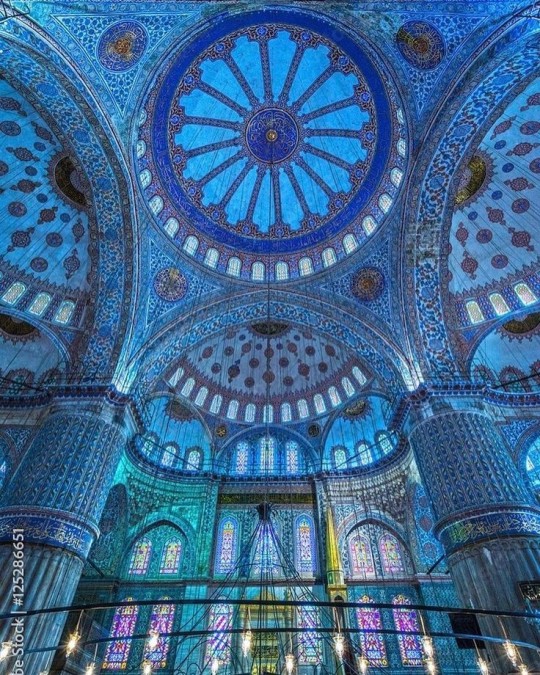


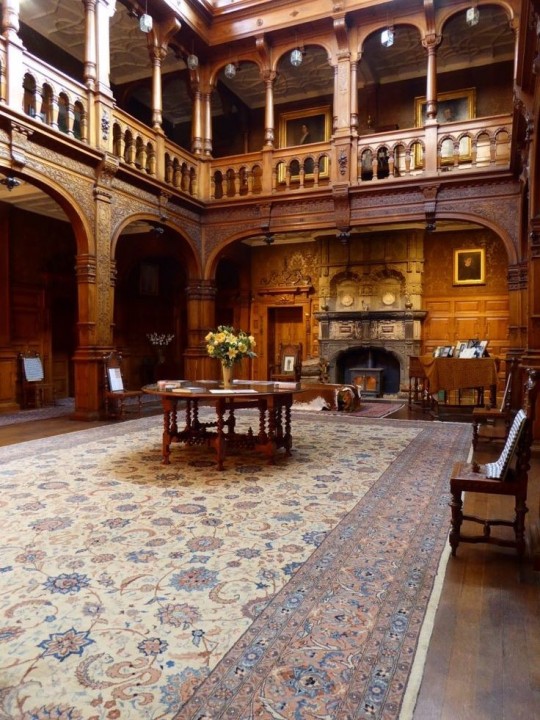
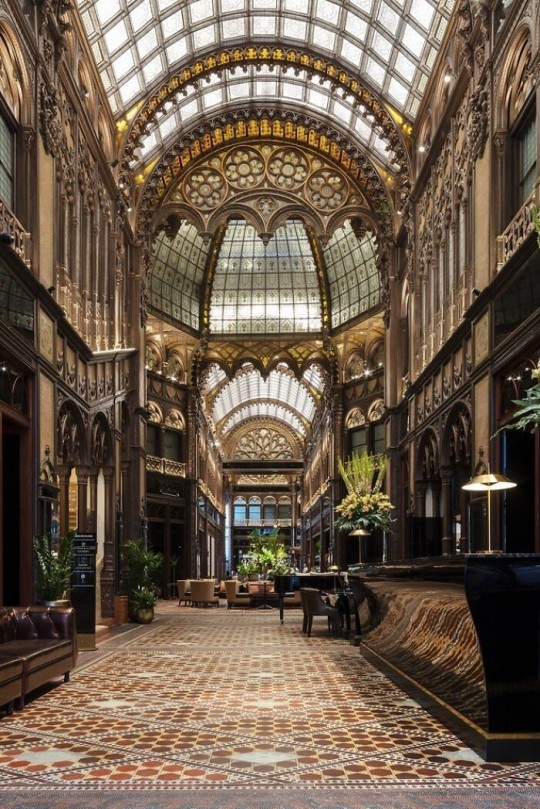
As a followup to the very popular post on architecture, I decided to add onto it by exploring the interior of each movement and the different design techniques and tastes of each era. This post at be helpful for historical fiction, fantasy or just a long read when you're bored.
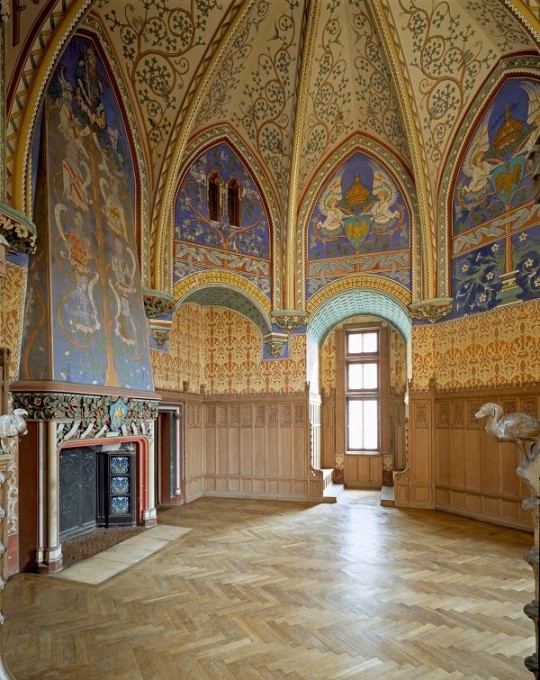
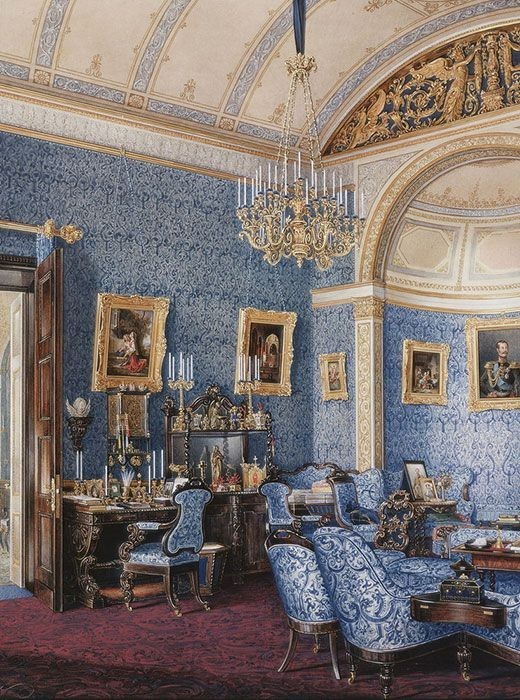
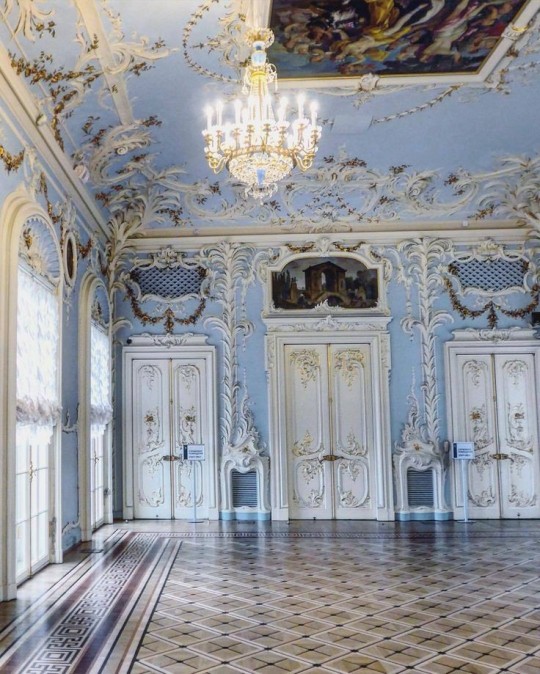
Interior Design Terms
Reeding and fluting: Fluting is a technique that consists a continuous pattern of concave grooves in a flat surface across a surface. Reeding is it's opposite.
Embossing: stamping, carving or moulding a symbol to make it stand out on a surface.
Paneling: Panels of carved wood or fabric a fixed to a wall in a continuous pattern.
Gilding: the use of gold to highlight features.
Glazed Tile: Ceramic or porcelain tiles coated with liquid coloured glass or enamel.
Column: A column is a pillar of stone or wood built to support a ceiling. We will see more of columns later on.
Bay Window: The Bay Window is a window projecting outward from a building.
Frescos: A design element of painting images upon wet plaster.
Mosaic: Mosaics are a design element that involves using pieces of coloured glass and fitted them together upon the floor or wall to form images.
Mouldings: ornate strips of carved wood along the top of a wall.
Wainscoting: paneling along the lower portion of a wall.
Chinoiserie: A European take on East Asian art. Usually seen in wallpaper.
Clerestory: A series of eye-level windows.
Sconces: A light fixture supported on a wall.
Niche: A sunken area within a wall.
Monochromatic: Focusing on a single colour within a scheme.
Ceiling rose: A moulding fashioned on the ceiling in the shape of a rose usually supporting a light fixture.
Baluster: the vertical bars of a railing.
Façade: front portion of a building
Lintel: Top of a door or window.
Portico: a covered structure over a door supported by columns
Eaves: the part of the roof overhanging from the building
Skirting: border around lower length of a wall
Ancient Greece
Houses were made of either sun-dried clay bricks or stone which were painted when they dried. Ground floors were decorated with coloured stones and tiles called Mosaics. Upper level floors were made from wood. Homes were furnished with tapestries and furniture, and in grand homes statues and grand altars would be found. Furniture was very skillfully crafted in Ancient Greece, much attention was paid to the carving and decoration of such things. Of course, Ancient Greece is ancient so I won't be going through all the movements but I will talk a little about columns.
Doric: Doric is the oldest of the orders and some argue it is the simplest. The columns of this style are set close together, without bases and carved with concave curves called flutes. The capitals (the top of the column) are plain often built with a curve at the base called an echinus and are topped by a square at the apex called an abacus. The entablature is marked by frieze of vertical channels/triglyphs. In between the channels would be detail of carved marble. The Parthenon in Athens is your best example of Doric architecture.
Ionic: The Ionic style was used for smaller buildings and the interiors. The columns had twin volutes, scroll-like designs on its capital. Between these scrolls, there was a carved curve known as an egg and in this style the entablature is much narrower and the frieze is thick with carvings. The example of Ionic Architecture is the Temple to Athena Nike at the Athens Acropolis.
Corinthian: The Corinthian style has some similarities with the Ionic order, the bases, entablature and columns almost the same but the capital is more ornate its base, column, and entablature, but its capital is far more ornate, commonly carved with depictions of acanthus leaves. The style was more slender than the others on this list, used less for bearing weight but more for decoration. Corinthian style can be found along the top levels of the Colosseum in Rome.
Tuscan: The Tuscan order shares much with the Doric order, but the columns are un-fluted and smooth. The entablature is far simpler, formed without triglyphs or guttae. The columns are capped with round capitals.
Composite: This style is mixed. It features the volutes of the Ionic order and the capitals of the Corinthian order. The volutes are larger in these columns and often more ornate. The column's capital is rather plain. for the capital, with no consistent differences to that above or below the capital.
Ancient Rome
Rome is well known for its outward architectural styles. However the Romans did know how to add that rizz to the interior. Ceilings were either vaulted or made from exploded beams that could be painted. The Romans were big into design. Moasics were a common interior sight, the use of little pieces of coloured glass or stone to create a larger image. Frescoes were used to add colour to the home, depicting mythical figures and beasts and also different textures such as stonework or brick. The Romans loved their furniture. Dining tables were low and the Romans ate on couches. Weaving was a popular pastime so there would be tapestries and wall hangings in the house. Rich households could even afford to import fine rugs from across the Empire. Glass was also a feature in Roman interior but windows were usually not paned as large panes were hard to make. Doors were usually treated with panels that were carved or in lain with bronze.
Ancient Egypt
Egypt was one of the first great civilisations, known for its immense and grand structures. Wealthy Egyptians had grand homes. The walls were painted or plastered usually with bright colours and hues. The Egyptians are cool because they mapped out their buildings in such a way to adhere to astrological movements meaning on special days if the calendar the temple or monuments were in the right place always. The columns of Egyptian where thicker, more bulbous and often had capitals shaped like bundles of papyrus reeds. Woven mats and tapestries were popular decor. Motifs from the river such as palms, papyrus and reeds were popular symbols used.
Ancient Africa
African Architecture is a very mixed bag and more structurally different and impressive than Hollywood would have you believe. Far beyond the common depictions of primitive buildings, the African nations were among the giants of their time in architecture, no style quite the same as the last but just as breathtaking.
Rwandan Architecture: The Rwandans commonly built of hardened clay with thatched roofs of dried grass or reeds. Mats of woven reeds carpeted the floors of royal abodes. These residences folded about a large public area known as a karubanda and were often so large that they became almost like a maze, connecting different chambers/huts of all kinds of uses be they residential or for other purposes.
Ashanti Architecture: The Ashanti style can be found in present day Ghana. The style incorporates walls of plaster formed of mud and designed with bright paint and buildings with a courtyard at the heart, not unlike another examples on this post. The Ashanti also formed their buildings of the favourite method of wattle and daub.
Nubian Architecture: Nubia, in modern day Ethiopia, was home to the Nubians who were one of the world's most impressive architects at the beginning of the architecture world and probably would be more talked about if it weren't for the Egyptians building monuments only up the road. The Nubians were famous for building the speos, tall tower-like spires carved of stone. The Nubians used a variety of materials and skills to build, for example wattle and daub and mudbrick. The Kingdom of Kush, the people who took over the Nubian Empire was a fan of Egyptian works even if they didn't like them very much. The Kushites began building pyramid-like structures such at the sight of Gebel Barkal
Japanese Interiors
Japenese interior design rests upon 7 principles. Kanso (簡素)- Simplicity, Fukinsei (不均整)- Asymmetry, Shizen (自然)- Natural, Shibumi (渋味) – Simple beauty, Yugen (幽玄)- subtle grace, Datsuzoku (脱俗) – freedom from habitual behaviour, Seijaku (静寂)- tranquillity.
Common features of Japanese Interior Design:
Shoji walls: these are the screens you think of when you think of the traditional Japanese homes. They are made of wooden frames, rice paper and used to partition
Tatami: Tatami mats are used within Japanese households to blanket the floors. They were made of rice straw and rush straw, laid down to cushion the floor.
Genkan: The Genkan was a sunken space between the front door and the rest of the house. This area is meant to separate the home from the outside and is where shoes are discarded before entering.
Japanese furniture: often lowest, close to the ground. These include tables and chairs but often tanked are replaced by zabuton, large cushions. Furniture is usually carved of wood in a minimalist design.
Nature: As both the Shinto and Buddhist beliefs are great influences upon architecture, there is a strong presence of nature with the architecture. Wood is used for this reason and natural light is prevalent with in the home. The orientation is meant to reflect the best view of the world.
Islamic World Interior
The Islamic world has one of the most beautiful and impressive interior design styles across the world. Colour and detail are absolute staples in the movement. Windows are usually not paned with glass but covered in ornate lattices known as jali. The jali give ventilation, light and privacy to the home. Islamic Interiors are ornate and colourful, using coloured ceramic tiles. The upper parts of walls and ceilings are usually flat decorated with arabesques (foliate ornamentation), while the lower wall areas were usually tiled. Features such as honeycombed ceilings, horseshoe arches, stalactite-fringed arches and stalactite vaults (Muqarnas) are prevalent among many famous Islamic buildings such as the Alhambra and the Blue Mosque.
Byzantine (330/395–1453 A. D)
The Byzantine Empire or Eastern Roman Empire was where eat met west, leading to a melting pot of different interior designs based on early Christian styles and Persian influences. Mosaics are probably what you think of when you think of the Byzantine Empire. Ivory was also a popular feature in the Interiors, with carved ivory or the use of it in inlay. The use of gold as a decorative feature usually by way of repoussé (decorating metals by hammering in the design from the backside of the metal). Fabrics from Persia, heavily embroidered and intricately woven along with silks from afar a field as China, would also be used to upholster furniture or be used as wall hangings. The Byzantines favoured natural light, usually from the use of copolas.
Indian Interiors
India is of course, the font of all intricate designs. India's history is sectioned into many eras but we will focus on a few to give you an idea of prevalent techniques and tastes.
The Gupta Empire (320 – 650 CE): The Gupta era was a time of stone carving. As impressive as the outside of these buildings are, the Interiors are just as amazing. Gupta era buildings featured many details such as ogee (circular or horseshoe arch), gavaksha/chandrashala (the motif centred these arches), ashlar masonry (built of squared stone blocks) with ceilings of plain, flat slabs of stone.
Delhi Sultanate (1206–1526): Another period of beautifully carved stone. The Delhi sultanate had influence from the Islamic world, with heavy uses of mosaics, brackets, intricate mouldings, columns and and hypostyle halls.
Mughal Empire (1526–1857): Stonework was also important on the Mughal Empire. Intricately carved stonework was seen in the pillars, low relief panels depicting nature images and jalis (marble screens). Stonework was also decorated in a stye known as pietra dura/parchin kari with inscriptions and geometric designs using colored stones to create images. Tilework was also popular during this period. Moasic tiles were cut and fitted together to create larger patters while cuerda seca tiles were coloured tiles outlined with black.
Chinese Interiors
Common features of Chinese Interiors
Use of Colours: Colour in Chinese Interior is usually vibrant and bold. Red and Black are are traditional colours, meant to bring luck, happiness, power, knowledge and stability to the household.
Latticework: Lattices are a staple in Chinese interiors most often seen on shutters, screens, doors of cabinets snf even traditional beds.
Lacquer: Multiple coats of lacquer are applied to furniture or cabinets (now walls) and then carved. The skill is called Diaoqi (雕漆).
Decorative Screens: Screens are used to partition off part of a room. They are usually of carved wood, pained with very intricate murals.
Shrines: Spaces were reserved on the home to honour ancestors, usually consisting of an altar where offerings could be made.
Of course, Chinese Interiors are not all the same through the different eras. While some details and techniques were interchangeable through different dynasties, usually a dynasty had a notable style or deviation. These aren't all the dynasties of course but a few interesting examples.
Song Dynasty (960–1279): The Song Dynasty is known for its stonework. Sculpture was an important part of Song Dynasty interior. It was in this period than brick and stone work became the most used material. The Song Dynasty was also known for its very intricate attention to detail, paintings, and used tiles.
Ming Dynasty(1368–1644): Ceilings were adorned with cloisons usually featuring yellow reed work. The floors would be of flagstones usually of deep tones, mostly black. The Ming Dynasty favoured richly coloured silk hangings, tapestries and furnishings. Furniture was usually carved of darker woods, arrayed in a certain way to bring peace to the dwelling.
Han Dynasty (206 BC-220 AD): Interior walls were plastered and painted to show important figures and scenes. Lacquer, though it was discovered earlier, came into greater prominence with better skill in this era.
Tang Dynasty (618–907) : The colour palette is restrained, reserved. But the Tang dynasty is not without it's beauty. Earthenware reached it's peak in this era, many homes would display fine examples as well. The Tang dynasty is famous for its upturned eaves, the ceilings supported by timber columns mounted with metal or stone bases. Glazed tiles were popular in this era, either a fixed to the roof or decorating a screen wall.
Romanesque (6th -11th century/12th)
Romanesque Architecture is a span between the end of Roman Empire to the Gothic style. Taking inspiration from the Roman and Byzantine Empires, the Romanesque period incorporates many of the styles. The most common details are carved floral and foliage symbols with the stonework of the Romanesque buildings. Cable mouldings or twisted rope-like carvings would have framed doorways. As per the name, Romansque Interiors relied heavily on its love and admiration for Rome. The Romanesque style uses geometric shapes as statements using curves, circles snf arches. The colours would be clean and warm, focusing on minimal ornamentation.
Gothic Architecture (12th Century - 16th Century)
The Gothic style is what you think of when you think of old European cathedrals and probably one of the beautiful of the styles on this list and one of most recognisable. The Gothic style is a dramatic, opposing sight and one of the easiest to describe. Decoration in this era became more ornate, stonework began to sport carving and modelling in a way it did not before. The ceilings moved away from barreled vaults to quadripartite and sexpartite vaulting. Columns slimmed as other supportive structures were invented. Intricate stained glass windows began their popularity here. In Gothic structures, everything is very symmetrical and even.
Mediaeval (500 AD to 1500)
Interiors of mediaeval homes are not quite as drab as Hollywood likes to make out. Building materials may be hidden by plaster in rich homes, sometimes even painted. Floors were either dirt strewn with rushes or flagstones in larger homes. Stonework was popular, especially around fireplaces. Grand homes would be decorated with intricate woodwork, carved heraldic beasts and wall hangings of fine fabrics.
Renaissance (late 1300s-1600s)
The Renaissance was a period of great artistry and splendor. The revival of old styles injected symmetry and colour into the homes. Frescoes were back. Painted mouldings adorned the ceilings and walls. Furniture became more ornate, fixed with luxurious upholstery and fine carvings. Caryatids (pillars in the shape of women), grotesques, Roman and Greek images were used to spruce up the place. Floors began to become more intricate, with coloured stone and marble. Modelled stucco, sgraffiti arabesques (made by cutting lines through a layer of plaster or stucco to reveal an underlayer), and fine wall painting were used in brilliant combinations in the early part of the 16th century.
Tudor Interior (1485-1603)
The Tudor period is a starkly unique style within England and very recognisable. Windows were fixed with lattice work, usually casement. Stained glass was also in in this period, usually depicting figures and heraldic beasts. Rooms would be panelled with wood or plastered. Walls would be adorned with tapestries or embroidered hangings. Windows and furniture would be furnished with fine fabrics such as brocade. Floors would typically be of wood, sometimes strewn with rush matting mixed with fresh herbs and flowers to freshen the room.
Baroque (1600 to 1750)
The Baroque period was a time for splendor and for splashing the cash. The interior of a baroque room was usually intricate, usually of a light palette, featuring a very high ceiling heavy with detail. Furniture would choke the room, ornately carved and stitched with very high quality fabrics. The rooms would be full of art not limited to just paintings but also sculptures of marble or bronze, large intricate mirrors, moldings along the walls which may be heavily gilded, chandeliers and detailed paneling.
Victorian (1837-1901)
We think of the interiors of Victorian homes as dowdy and dark but that isn't true. The Victorians favoured tapestries, intricate rugs, decorated wallpaper, exquisitely furniture, and surprisingly, bright colour. Dyes were more widely available to people of all stations and the Victorians did not want for colour. Patterns and details were usually nature inspired, usually floral or vines. Walls could also be painted to mimic a building material such as wood or marble and most likely painted in rich tones. The Victorians were suckers for furniture, preferring them grandly carved with fine fabric usually embroidered or buttoned. And they did not believe in minimalism. If you could fit another piece of furniture in a room, it was going in there. Floors were almost eclusively wood laid with the previously mentioned rugs. But the Victorians did enjoy tiled floors but restricted them to entrances. The Victorians were quite in touch with their green thumbs so expect a lot of flowers and greenery inside. with various elaborately decorated patterned rugs. And remember, the Victorians loved to display as much wealth as they could. Every shelf, cabinet, case and ledge would be chocked full of ornaments and antiques.
Edwardian/The Gilded Age/Belle Epoque (1880s-1914)
This period (I've lumped them together for simplicity) began to move away from the deep tones and ornate patterns of the Victorian period. Colour became more neutral. Nature still had a place in design. Stained glass began to become popular, especially on lampshades and light fixtures. Embossing started to gain popularity and tile work began to expand from the entrance halls to other parts of the house. Furniture began to move away from dark wood, some families favouring breathable woods like wicker. The rooms would be less cluttered.
Art Deco (1920s-1930s)
The 1920s was a time of buzz and change. Gone were the refined tastes of the pre-war era and now the wow factor was in. Walls were smoother, buildings were sharper and more jagged, doorways and windows were decorated with reeding and fluting. Pastels were in, as was the heavy use of black and white, along with gold. Mirrors and glass were in, injecting light into rooms. Gold, silver, steel and chrome were used in furnishings and decor. Geometric shapes were a favourite design choice. Again, high quality and bold fabrics were used such as animal skins or colourful velvet. It was all a rejection of the Art Noveau movement, away from nature focusing on the man made.
Modernism (1930 - 1965)
Modernism came after the Art Deco movement. Fuss and feathers were out the door and now, practicality was in. Materials used are shown as they are, wood is not painted, metal is not coated. Bright colours were acceptable but neutral palettes were favoured. Interiors were open and favoured large windows. Furniture was practical, for use rather than the ornamentation, featuring plain details of any and geometric shapes. Away from Art Deco, everything is straight, linear and streamlined.
#This took forever#I'm very tired#But enjoy#I covered as much as I could find#Fantasy Guide to interiors#interior design#Architecture#writings#writing resources#Writing reference#Writing advice#Writer's research#writing research#Writer's rescources#Writing help#Mediaeval#Renaissance#Chinese Interiors#Japanese Interiors#Indian interiors#writing#writeblr#writing reference#writing advice#writer#spilled words#writers
3K notes
·
View notes
Text
🌷Summer Skincare Recommendations🌷
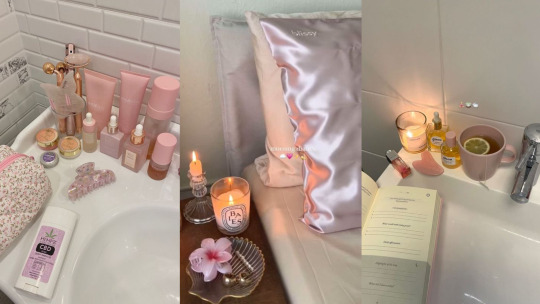
Hey babesss the summer is officially hereeeeee and I am so excited and I need to keep my girliesss skincare in check okay! So I will be listing my skincare favorites below that you can purchase on Amazon. Always consult your dermatologist and do your thorough research on these products to see if they will benefit your skin type. I will be rating everything out of 5 stars⭐️ <3333
Cleansers
♡ ANUA Heartleaf Quercetinol Pore Deep Cleansing Foam
⭐️ ⭐️ ⭐️ ⭐️ ⭐️
♡ ANUA Heartleaf Pore Control Cleansing Oil ⭐️ ⭐️ ⭐️ ⭐️ ⭐️
♡ Beauty of Joseon Green Plum Refreshing Cleanser Gel
⭐️ ⭐️ ⭐️ ⭐️
♡ ROUND LAB 1025 Dokdo Cleanser ⭐️ ⭐️ ⭐️ ⭐️
♡ COSRX Low pH Good Morning Gel Cleanser ⭐️ ⭐️ ⭐️
Toners
♡ I'm from Rice Toner Milky Toner for Glowing Skin ⭐️ ⭐️ ⭐️ ⭐️
♡ ANUA Heartleaf 77 Soothing Toner ⭐️ ⭐️ ⭐️ ⭐️ ⭐️
♡ Beauty of Joseon Ginseng Essence Water Hydrating Face Toner ⭐️ ⭐️ ⭐️ ⭐️
♡ ANUA Heartleaf 77 Toner Pad ⭐️ ⭐️ ⭐️ ⭐️ ⭐️
♡ Beauty of Joseon Glow Replenishing Rice Facial Sebum Toner for Oily Combination Acne Skin ⭐️ ⭐️ ⭐️ ⭐️ ⭐️
♡ COSRX AHA/BHA Clarifying Treatment Toner ⭐️ ⭐️ ⭐️ ⭐️ ⭐️
Serums
♡ Topicals Faded Brightening and Clearing Serum ⭐️ ⭐️ ⭐️ ⭐️ ⭐️
♡ Beauty of Joseon Glow Serum Propolis and Niacinamide Hydrating Facial ⭐️ ⭐️ ⭐️ ⭐️
♡ SKIN1004 Madagascar Centella Asiatica Ampoule Facial Serum ⭐️ ⭐️ ⭐️ ⭐️
♡ Youth To The People 15% Vitamin C Face Serum ⭐️ ⭐️ ⭐️
♡ Anua Peach 70 Niacinamide Serum ⭐️ ⭐️ ⭐️ ⭐️ ⭐️
Moisturizers
♡ Bio-Oil Skincare Body Oil, Serum for Scars and Stretchmarks, Face Moisturizer ⭐️ ⭐️ ⭐️ ⭐️ ⭐️
♡ Beauty of Joseon Dynasty Cream Hydrating Face Moisturizer
⭐️ ⭐️ ⭐️ ⭐️
♡ Illiyoon Ceramide Ato Concentrate Cream Korean Moisturizer
⭐️ ⭐️ ⭐️ ⭐️
Eyecreams
♡ Medicube Deep Reviving Peptide Eye Cream ⭐️ ⭐️ ⭐️ ⭐️ ⭐️
♡ COSRX Retinol Cream, 0.67 Oz, Anti-aging Eye & Neck Cream with Retinoid ⭐️ ⭐️ ⭐️
♡ Beauty of Joseon Revive Eye Serum with Retinal Niacinamide Correction ⭐️ ⭐️ ⭐️ ⭐️
Sunscreen
♡ ROUND LAB Birch Juice Moisturizing Sunscreen ⭐️ ⭐️ ⭐️ ⭐️
♡ Neutrogena Clear Face Liquid Lotion Sunscreen ⭐️ ⭐️ ⭐️ ⭐️ ⭐️
♡ La Roche-Posay Anthelios Light Fluid Facial Sunscreen ⭐️ ⭐️ ⭐️
Face Masks
♡ COSRX Snail Mucin Sheet Mask ⭐️ ⭐️ ⭐️ ⭐️
♡ Collagen Lifting Mask ⭐️ ⭐️ ⭐️ ⭐️ ⭐️
♡ Aztec Secret Indian Healing Clay Deep Pore Cleansing Facial & Body Mask ⭐️ ⭐️ ⭐️ ⭐️
Skincare Tools
♡ BAIMEI Jade Roller & Gua Sha Set Face Roller and Gua Sha Facial Tools
♡ Colorfarm Facial Steamer Nano Ionic: Face Steamer Deep Cleaning Unclogs Pores - Humidifier
♡ Ice Roller for Face, Ice Face Roller & Eye Puffiness Relief
♡ 7 Colors Led Light Therapy Facial Mask, Face Light Therapy Mask for Face
♡ NuFACE MINI+ Microcurrent Facial Device Kit - FDA Cleared Face Sculpting & Skin Tightening Device

#new month#becoming that girl#dream girl#girlblogging#dream life#it girl#glow up#productivity#that girl#clean girl#pink pilates girl#self improvement#self care#green juice girl#it girl energy#becoming her#self love#soft productivity#productivitytips#consistency#self growth#routines#healthyhabits#wellness#positivity#girljournal#hyper feminine#motivation#my diary#pink blog
138 notes
·
View notes
Text
1. Be nice to the weird guy and see what happens

barry allen x female reader
word count: 1745
part one out of 8
He liked to sit next to you at the cafeteria because nobody else would have him; he was the chatty, obnoxious dude with the weird laughter who annoyed the fuck out of anybody who had the rotten luck of spending time with him. It was known that during the classes, he was definitely useful to some; being all open and helpful with the late homework, difficult passages and intricate nuances of law. His real love was physics, though, and if he started babbling about it, one could shoot oneself in the mouth.
You didn't mind. Perhaps it was the fact that Barry was extremely easy on the eye - the whole sculptured face and the articulate mouth thing going on. But, rather, you liked to listen to his theories in the breaks, between literature, history of literature, critical literature, medieval literature... well, there was a lot of lit. Once you got through his initial jokes, complicated formulations and extremely long lyrical digressions, you started hearing really interesting things. Maybe you were a little bit more patient than everybody else. Maybe you just clicked.
Thus you spent almost all breaks at college. You'd emerge from the different sides of the building in the messy crowd of peers, and meet at the cafeteria where only one table could tolerate Barry Allen. You'd always switch lunches; you were dead set on eating more dairy because it was good for stomach, but, ironically, you couldn't stomach (pun intended) the feeling of yoghurt in your mouth. Not hard, not liquid, what is this thing, yoghurt? Yet, you bravely bought it every time, and then, after a couple of spoons, gagged, and after several weeks Barry was already accustomed to silently switch trays with you. He always bought the second one anyway. The dude ate for three and was still lean, almost slender.
You'd listen to his ramblings about equations until you got bored, and then would start asking him actually relevant questions.
Barry, how the fuck do we build the ionic engine asap? Barry, is that possible, that a person, not a metahuman, but a usual human, could hold gusts of dark matter inside and have the cells tolerate it? Barry, how the heck do mirrors work?
He was always happy to talk about it with you. You liked each other. You were nice to the weird guy who was being mildly bullied, frowned upon, by other students; and this way, you got your first friend at Central City College.
It's been months before you started noticing some strange things about your hyperactive, gluttonous, OCD, nervous, obnoxious friend.
First, that building collapse that happened on Thursday, 12th of December, and when the phones of the entire classroom started going off, you thought immediately about telling your friend, Barry. It's a natural reaction. You were puzzled not to see him in the cafeteria, or anywhere in the College, although you'd seen each other that morning, and moreover, Barry skipped studies very rarely. You thought it odd and texted him, and only got the reply very late that night:
"Sorry, I had to run, eaten something reeeeeeeeeaaaaaaally shitty. Yeha, I've seen on the news. Crazy. Cool that Batman and the Flash were there".
He always, always misspelt 'yeah'.
You wouldn't build the whole picture until much later, when you started seeing a pattern. Barry acted really weird when talking about metahumans. Not that it was your favorite topic, or you spoke about it often. But every time, he would start nervously stuttering and blinking like thirty times faster, and try to change the subject.
Uhm, yeah? The Flash, he's- he's really cool, yeah? So... fast!
The usually talkative, imaginative Barry was at loss when talking about them. If you'd ask him to characterize the metahumans, he'd describe all of them as 'cool' and 'fast'.
Then, there were these sudden disappearances when something occurred in the city or elsewhere. Of course, when you look at it with the perspective, it's laughably obvious, but while the history is writing itself... yes, Barry has gone rogue here and there during the classes, and then reappeared a day later, and happened to slack at replying to you, but you didn't text to each other that often. So the crazy realization came to you a different way.
The Justice League did not like the spotlight very much. The most outspoken and open ones were Wonder Woman and Aquaman. Those two, they were so invincible that they had nothing to be afraid of. Always smiling confidently and calmly, with nothing but polite words of support, should they happen to meet someone who'd recognize them. Batman, Cyborg and Superman were the different tale. They were secretive, quiet, evasive. They were the real cool heroes, who left the intrigue hanging, made everyone ask questions and hope for excitement. You yourself have written 2000 words on the phenomenon of mysertious identities of the team, for your creative writing homework.
But the Flash. The fastest person on the planet was the hardest to catch, and at the same time, the pictures of his face, out of those four who were hiding their identities, were of the best quality.
There were three pictures: one from Gotham City a year ago, when a bridge has been blown up, and the team gathered to deal with the aftermath. The shot was not too blurry, with his back turned, but you could see the way he was standing, resting, like an Olympic runner.
Second picture was a picture of his face, but relatively bad; it was probably a maximized shot cut out from somewhere. You could be looking at a mashed potato and trying to guess the eyes and the mouth.
Third, was a picture of the whole team from Laos, where they were doing god knows what, honestly, you weren't that interested in superpeople. The news headline said that they had located the position of the weapon smugglers, and Batman took charge unlawfully, and the whole Justice League was in peril. Not for the Flash though! That day also provided a video of him, probably a very foolish thing to do for someone who is trying to stay unknown. You got a close up Batman, who was trying to shove the camera down, and then, seemingly from under his elbow, the bright red Flash appeared, very close, his face at 45 degrees to the camera. Looking briefly into the lense, he said,
"Umm, I, like, see the remains out there, I'll go then chief".
Utter gibberish, said in the same voice that always told you tales of speed, and particles, and timeline, during lunch breaks.
You weren't looking or investigating on purpose; it was just boredom. It was February, and you had cold. You were browsing the news to be aware of the next essay point. And then you saw this guy, with parasite words flooding his speech, so close to the camera that you paused, and leaned in, and yelled,
"What the fuck?!"
Later that week, after you got better and returned to studies, you met Barry at cafeteria during the break. It was pretty much the only times you met at all, but friendship was string, joyful, and mutually respectful. You started noticing the limp that he hadn't had five days ago, and the way his cheekbones might just be the most recognizable cheekbones in the world. Barry Allen was also granted some of the most distinctive voices you'd heard: capricious, like a chainsaw working. Once you'd heard it, you'd never forget.
You pretended to eat like nothing happens as he told you about every little fucking thing that happened at the College while you were away.
You considered being decent and talk to him eye to eye, but the curiosity, boredom, got the best of you, and you snapped right after you've finished your meals.
As you left the cafeteria and walked across the yard to get into the next building, to the library, you phased in and returned to reality, only to discover he was still talking.
"Are you the Flash?" you asked quietly, snugging closer to him.
You could see the closeness at first startled him; his eyes darted from your shoulder to your face, but then the information reached his brain.
"Why would you say that?" he asked.
You stood in front of him, almost laughing.
"What do you mean? I've seen one video", you whispered, "and realized it was you. I mean- it would be more difficult not to see it. And your voice, it was your voice!"
Barry clasped his hands together as if he was a boy being told off.
"Well, I've also seen the resemblance, and..."
You took your phone and opened the screenshot you'd taken, and put it next to his face to compare. Barry's hand was on your immediately, taking the phone down. Seriousness changed into joking denial.
"Come on, I mean, I take it as a compliment, but I can't possibly be the Fla-hu-huhsh".
His laughter drew a wall between you. In a moment, for some fucked up reason, you felt misunderstood, and hurt.
"Why are you denying this? I won't tell anyone", you looked around, at the utterly indifferent surrounding, where people wouldn't care if you two got completely undressed and started eating soil.
"I am your friend. I was just so flabbergasted to find this out. But I won't tell anyone".
Barry looked lost. He seemed like a boy so much at that moment, not knowing what to say.
He knew you wouldn't tell. He was surpried it took you more than two months to realize who he was. Bruce and Diana were dead set on keeping him anonymous. Bruce especially; he was constantly paranoid about Barry, and what he did to compromise himself, and his social circle (although he said a number of times he didn't have any). He would butcher the idea into his head almost every time they went on a mission: be careful, don't interact with anyone, don't let people look into your face too much; the mask is too revealing.
He was now in between. The idea that Y/N would know him for real made him feel more special than even his powers.
"I'm sorry, I am not the Flash", he said. He watched your face close down with disappointment.
"It's okay, I understand, I guess".
Why did she have to be so stubborn though? It's like, every time Y/N knew something, or thought she knew something, nothing would turn her around, not even the reality.
65 notes
·
View notes
Text
poikilotherm robot boy with ionic liquid blood
2 notes
·
View notes
Text
Ionic liquids (figure 12.37) are increasingly being advocated as green solvents for electrochemical applications in metal deposition, battery electrolytes and electrosynthesis.

"Chemistry" 2e - Blackman, A., Bottle, S., Schmid, S., Mocerino, M., Wille, U.
#book quotes#chemistry#nonfiction#textbook#ionic liquid#ionic#miscibility#water#solvent#green chemistry#electrochemistry#metal deposition#battery#electrolytes#electrosynthesis
0 notes